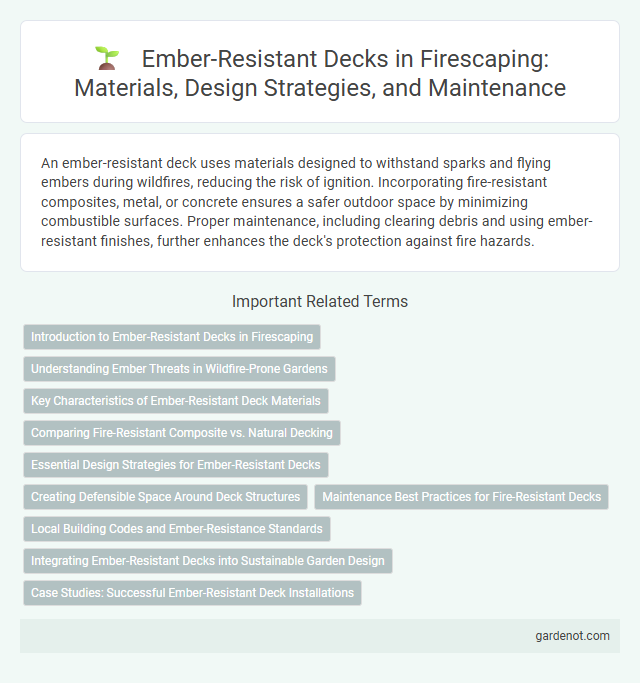An ember-resistant deck uses materials designed to withstand sparks and flying embers during wildfires, reducing the risk of ignition. Incorporating fire-resistant composites, metal, or concrete ensures a safer outdoor space by minimizing combustible surfaces. Proper maintenance, including clearing debris and using ember-resistant finishes, further enhances the deck's protection against fire hazards.
Introduction to Ember-Resistant Decks in Firescaping
Ember-resistant decks are designed to minimize the risk of ignition from airborne embers during wildfires, using non-combustible materials like metal, concrete, or ember-resistant composites. These decks incorporate fire-resistant fasteners and structural components to prevent ember infiltration and ignition. Integrating ember-resistant decks into firescaping strategies significantly enhances the overall defensible space around homes in wildfire-prone areas.
Understanding Ember Threats in Wildfire-Prone Gardens
Ember-resistant decks are crucial in wildfire-prone gardens, as embers can travel miles and ignite wooden structures. Using non-combustible materials such as metal, concrete, or fire-retardant composite decking minimizes the risk of ember ignition. Proper design includes sealing gaps where embers might accumulate, reducing potential fire spread and enhancing overall landscape resilience.
Key Characteristics of Ember-Resistant Deck Materials
Ember-resistant deck materials feature non-combustible surfaces such as fiber cement, metal, or treated wood composites designed to reduce ignition risk from airborne embers during wildfires. These materials often possess fire-retardant properties and tightly sealed joints to prevent ember intrusion and limit flame spread. Their durability against heat and resistance to cracking ensure prolonged protection and structural integrity under high-temperature exposure.
Comparing Fire-Resistant Composite vs. Natural Decking
Fire-resistant composite decking offers superior ember resistance compared to natural wood, significantly reducing the risk of ignition from flying embers during wildfires. Composite materials are engineered with non-combustible additives and tightly bonded fibers, providing enhanced durability against heat and flames. Natural decking, while aesthetically pleasing, tends to be more susceptible to ember sparks and may require additional treatments to improve fire resistance.
Essential Design Strategies for Ember-Resistant Decks
Ember-resistant decks incorporate non-combustible materials such as fiber-cement or metal decking paired with tempered glass or metal railings to prevent ignition from flying embers. Strategic placement of ember-resistant vegetation and maintaining a clear zone free of flammable debris around the deck further reduces fire risk. Integrating fire-resistant barriers and sealing gaps where embers could enter minimizes vulnerability, ensuring a safer outdoor living space in wildfire-prone areas.
Creating Defensible Space Around Deck Structures
Creating defensible space around ember-resistant decks involves clearing flammable vegetation and debris within a 30-foot perimeter to reduce ignition risks from wind-blown embers. Using non-combustible materials such as metal or concrete for deck skirting and choosing ember-resistant plants enhances the deck's fire resilience. Maintaining a well-irrigated landscape and regularly removing dead leaves, pine needles, and other combustible materials further protects deck structures from wildfire exposure.
Maintenance Best Practices for Fire-Resistant Decks
Regular cleaning of ember-resistant decks by removing leaves, pine needles, and debris minimizes ignition risks during wildfire season. Inspecting and sealing the deck surfaces with fire-retardant coatings enhances durability and maintains ember resistance. Clearing nearby vegetation and ensuring proper drainage further reduce fire hazards and support long-term fire-safe deck maintenance.
Local Building Codes and Ember-Resistance Standards
Ember-resistant decks must comply with local building codes such as California's PRC 4291, which mandates the use of non-combustible or ignition-resistant materials to reduce wildfire risks. Ember-resistance standards, including those outlined by ASTM E2768, specify performance criteria for decking materials to withstand embers and spot fires. Adhering to these regulations ensures decks offer enhanced protection against ember intrusion during wildfires.
Integrating Ember-Resistant Decks into Sustainable Garden Design
Ember-resistant decks use non-combustible materials such as composite decking, fiber cement boards, or fire-treated wood to reduce the risk of ignition from airborne embers during wildfires. Integrating these decks into sustainable garden design promotes fire resilience while supporting eco-friendly landscaping with drought-tolerant plants and permeable surfaces. Strategic placement of ember-resistant decks near low-flammability plants enhances overall garden safety and reduces maintenance needs.
Case Studies: Successful Ember-Resistant Deck Installations
Case studies demonstrate that ember-resistant decks constructed with fire-resistant materials like composite decking, metal fasteners, and non-combustible underlayment significantly reduce ignition risk in wildfire-prone areas. Installations in California and Australia show that integrating ember-resistant design principles with proper spacing and ember barriers enhances overall deck durability and fire safety. Data from these projects indicate a notable decrease in fire-related damages, supporting ember-resistant decks as a critical component of effective firescaping strategies.
Ember-resistant deck Infographic

 gardenot.com
gardenot.com